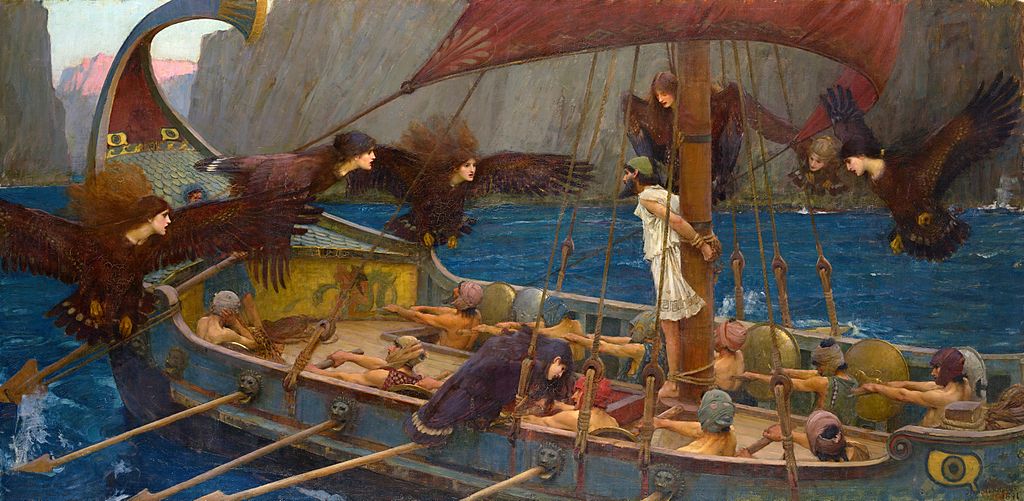
“Ulysses and the Sirens” by John William Waterhouse dramatically illustrates an episode from the Greek hero Odysseus’s journey home after the Trojan War. Odysseus is also known by the Latin variant Ulysses.
This painting depicts the incident in which the infamous Sirens lured unwary sailors towards perilous rocks and their doom by singing their enchanting songs.
Ulysses was curious to hear the Sirens song, and so, on Circe’s advice, he had all of his sailors plug their ears with beeswax and then allowed himself to be tied to the mast. He ordered his men to leave him tied tightly to the mast, no matter how much he would beg.
When Ulysses heard their beautiful song, he ordered the sailors to untie him, but they bound him tighter. When they had passed out of earshot, Odysseus was released.
Waterhouse has depicted the Siren with the body of a bird and the head of a beautiful woman. This depiction was a surprise to his Victorian-era audiences, which were used to seeing these mythic creatures portrayed as beautiful mermaid-like nymphs.
After seeing the bird body’s motif on an ancient Greek vase in the British Museum, Waterhouse took this unconventional approach.
When “Ulysses and the Sirens” was first exhibited at London’s Royal Academy in 1891, the painting was praised by most art critics of the day. One critic declared it:
“a very startling triumph … a very carnival of color, mosaicked and balanced with a skill more consummate than even the talented artist was credited with.”
Odysseus – Ulysses
Odysseus, also known by the Latin variant Ulysses, was a Greek king of Ithaca and the hero of Homer’s epic poem the Odyssey. Odysseus also plays a key role in Homer’s Iliad.
Odysseus is renowned for his intellectual brilliance, guile, and versatility. He is famous for his ten years journey home after the decade-long Trojan War.
In Greek mythology, the Sirens were dangerous creatures who lured sailors with their enchanting music and singing voices to shipwreck on their island’s rocky coast.
Odysseus was curious as to what the Sirens sang to him, and so, on the advice of Circe, he had all of his sailors plug their ears with beeswax and tie him to the mast.
However, he ordered his men to leave him tied tightly to the mast, no matter how much he might beg. When he heard their beautiful song, he ordered the sailors to untie him, but they bound him tighter.
When they had passed out of earshot, Odysseus was released. The Sirens were fated to die if someone heard their singing, escaped them, flung themselves into the water, and perished.
Ulysses and the Sirens
- Title: Ulysses and the Sirens
- Artist: John William Waterhouse
- Medium: Oil on canvas
- Date: 1891
- Style: Pre-Raphaelite
- Dimensions: Height: 100.6 cm (39.6″); Width: 202 cm (79.5″)
- Museum: National Gallery of Victoria
John William Waterhouse
John William Waterhouse (1849 – 1917) worked in the Pre-Raphaelite style, several decades after the breakup of the Pre-Raphaelite Brotherhood, which included artists such as Dante Gabriel Rossetti, John Everett Millais, and William Holman Hunt.
Waterhouse embraced the Pre-Raphaelite style even though it had gone out of fashion in the British art scene by the time of this painting.
John William Waterhouse
- Name: John William Waterhouse
- Born: 1849 – Rome, Papal States
- Died: 1917 (aged 67) – London, England, United Kingdom
- Nationality: British
- Movement: Pre-Raphaelite
- Notable works:
- The Lady of Shalott
- The Favorites of the Emperor Honorius
- Circe Invidiosa
- Diogenes
- I Am Half-Sick of Shadows, Said the Lady of Shalott
- Hylas and the Nymphs
- Echo and Narcissus
- Ulysses and the Sirens
- Consulting the Oracle
- A Tale from the Decameron
- Circe Offering the Cup to Ulysses
- Saint Eulalia
- Fair Rosamund
Sirens
A Virtual Tour of Pre-Raphaelite Artists
John Everett Millais
- Isabella
- Christ in the House of His Parents
- The Martyr of Solway
- Ophelia
- Blow Blow Thou Wind
- The Black Brunswicker
- A Dream of the Past: Sir Isumbras at the Ford
William Holman Hunt
- Christ in the House of His Parents
- Our English Coasts
- Isabella and the Pot of Basil
- Self-portrait William Holman Hunt
Paintings of Homer’s Epic Tale, The Odyssey
Dante Gabriel Rossetti
- Lady Lilith
- Dante’s Dream
- Dante Gabriel Rossetti – Self Portrait
- The Beloved
John William Waterhouse
- The Lady of Shalott
- The Favorites of the Emperor Honorius
- Circe Invidiosa
- Diogenes
- I Am Half-Sick of Shadows, Said the Lady of Shalott
- Hylas and the Nymphs
- Echo and Narcissus
- Ulysses and the Sirens
- Consulting the Oracle
- A Tale from the Decameron
- Circe Offering the Cup to Ulysses
- Saint Eulalia
- Fair Rosamund
The Odyssey (2017) – The Island Of Sirens Scene
Marie Spartali Stillman
- Love’s Messenger
Ford Madox Brown
- The Star of Bethlehem
- King Cophetua and the Beggar Maid
Henry Holiday
- Dante and Beatrice
Edward Burne-Jones
- The Star of Bethlehem
- King Cophetua and the Beggar Maid
Frederick Sandys
- Queen Eleanor
- Morgan-le-Fay
- Mary Magdalene
The Siren’s song – the gods are without pity.
~~~
“Some things you will think of yourself,…some things God will put into your mind.”
– Homer, The Odyssey
~~~
Photo Credit: 1) John William Waterhouse / Public domain via Wikimedia Commons;
Popular this Week








 Sponsor your Favorite Page
Sponsor your Favorite Page SEARCH Search for: Search Follow UsJoin – The JOM Membership Program
Sponsor a Masterpiece with YOUR NAME CHOICE for $5
Share this:
- Tweet
